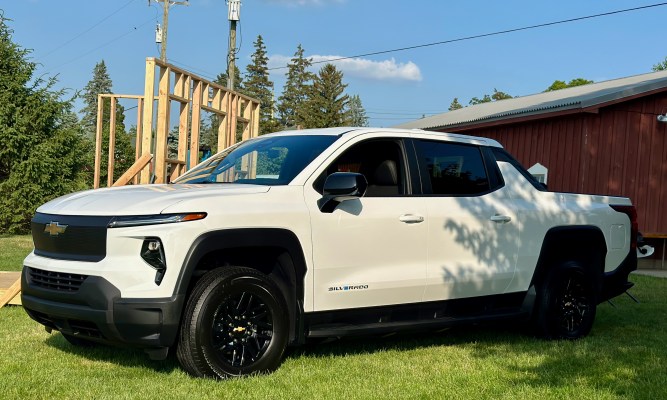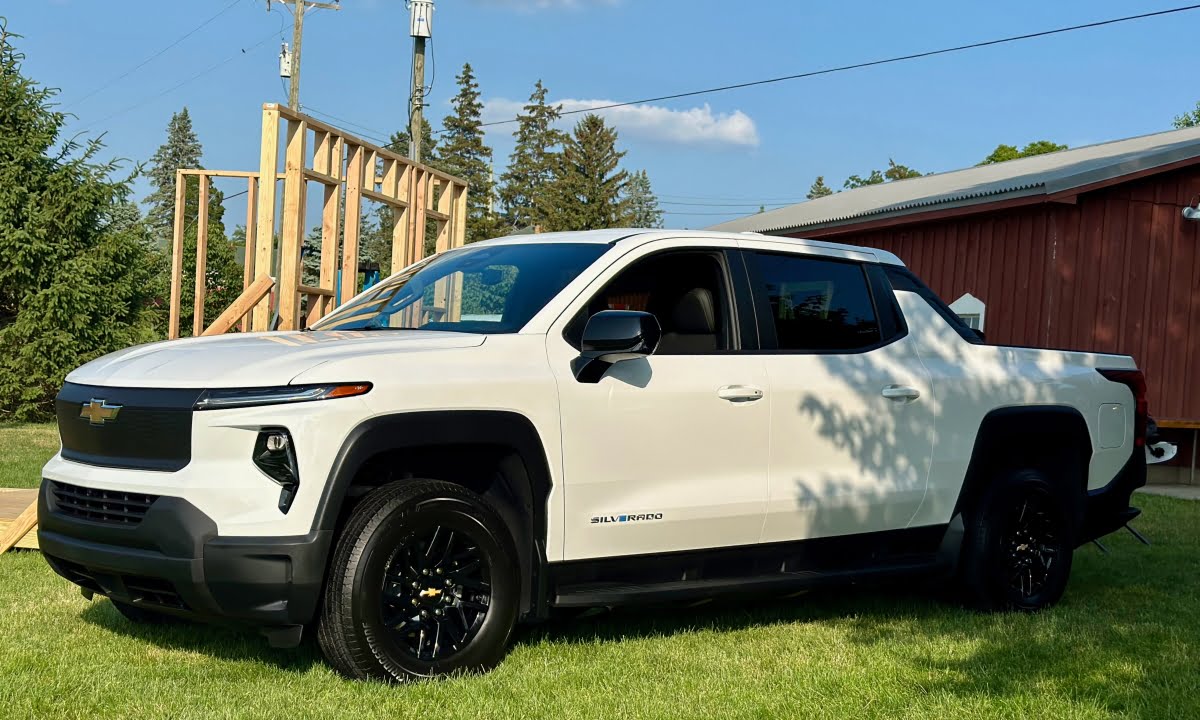The 2024 Silverado EV WT impresses with a 450-mile range and outstanding towing
At $77,905 this truck is trying to redefine ‘work truck’

I hope you like gray.
The 2024 Chevrolet Silverado EV Work Truck is, well, a work truck. Besides the impressive Ultima EV powertrain, there’s nothing spectacular about this truck. The seats have manual adjustments; the LCD control screens are small with huge bezels. Everything is gray, from the dashboard to the seats to the wheel fenders. There are no chrome accents or automated driving features. The Silverado EV WT is basic in every way, but the price and range: $77,905 and 450 miles on a charge.
In other words, it’s perfect. Chevrolet’s Work Truck package is designed for customers who believe less is more — fewer frills, more bills.
Chevy has long offered the work truck package as an option to its pickups. It’s designed for those who want to get the job done without buying extra features. In this pickup, that means buyers are telling Chevy to just give them an electric powertrain, a few seats and a 5-foot, 11-inch bed. I love it.
Before testing the truck, my main concern was its towing capabilities (which we’ll get to shortly). However, I found everything else to be more than capable and adequate, which was reassuring. The driving experience was pleasant, with ample power and a sturdy ride. The truck’s interior is functional and straightforward.
The $77,905 starting price may be too expensive for some due to its basic interior features. In comparison, a Chevy V8 work truck with similar features starts at $49,000. Meanwhile, Ford’s EV work truck begins at $59,000, but offers a shorter truck bed and less electric range compared to the Chevy.
Nuts and bolts
I recently spent the morning driving the Silverado EV WT through tree-lined farm roads in lower Michigan. A few things were immediately apparent. The truck is heavy. You can feel it in how the body sways and rolls around curves. The large battery pack sits under the passenger compartment. The battery drops the traditional center of gravity lower than an ICE pickup. This improves the ride and handling over conventional pickups that often jerk and skitter when not carrying a load.
I threw it into corners, and the truck remained relatively flat. The truck stayed planted as it rounded traffic circles and highway on-ramps. Even when stomping on the electric gas, the Silverado EV remained level instead of rearing up and squatting on the rear tires. The long and wide battery gives the truck an even weight distribution and makes it feel more sturdy than an ICE pickup.
It’s worth noting that the Silverado EV has a coil spring suspension at the back instead of leaf springs. This type of suspension usually provides better handling both on and off-road, and it has been implemented beautifully in the Silverado. While coil spring suspensions have been found in Ram trucks for some time and more recently, in Toyotas, GM and Ford have historically used leaf springs. At least, in their gas-powered trucks.
The Silverado EV truck is quick enough, but won’t beat a Lightning or the Cybertruck (which has yet to go into production) in a drag race. Despite having 615 pound-feet of torque and 510 hp on tap, the truck doesn’t launch off the line. The upcoming Silverado EV RST variant should be more impressive if speed is your thing. Chevy previously claimed the RST version, with 780 lb.-ft. of torque and 665 HP will sprint to 60 mph in 4.5 seconds in a so-called WOW mode (Wide Open Watts).
Let’s talk about towing
Towing is where this vehicle stands apart from its gas counterparts. The 2024 Chevrolet Silverado EV Work Truck is rated to tow 10,000 pounds, which is on par with other light-duty gas-powered pickups.
After spending a morning pulling a 6,000-pound trailer, I can attest the pickup offers a serious advantage over an internal combustion-powered light-duty truck. At speed, the pickup easily tows a trailer. But at slow speeds — say backing a trailer into a tight spot — the EV work truck effortlessly maneuvers thanks to the electric motor’s instant torque. I tow a lot of trailers, and this is the first time I’ve had a light-duty pickup feel this good at low-speed maneuvering (more on towing later).
There is a downside. The electric range takes a significant hit when towing. Chevy estimates the range drops 50% when towing 5,000 lbs. If the driver connects a trailer or engages tow mode, the dashboard battery level automatically drops by 50% and adjusts on the fly to reflect the real-world conditions. Are you pulling less than 5,000 lbs? The battery level could drain slower than expected, while towing more could result in a faster reduction.
During my short towing test, I found the range estimate accurate. Chevy provided me with a two-axle trailer holding a large John Deere tractor. I jumped in the driver’s seat and hit the road. The truck was much slower off the line with the weight on the back. When I put the pedal to the floor, the truck got to speed promptly without feeling like it was straining. My 2016 Ford F-150 3.5l EcoBoost would have been screaming under the same test, and it’s rated to tow more than 12,000 lbs.
The truck easily cruised around the two-lane farm roads with the trailer connected. Towing at speed was uneventful and practically the same as any other light-duty pickup. The extra weight on the hitch caused the truck to bob and sway, but less so than if I pulled it in my gas-powered truck. Then I pulled into a parking lot and was instantly impressed.
Backing up a trailer is a careful balancing act of throttle control. Too much power, and the trailer can quickly get off course. Too little, and the trailer doesn’t move at all. Modern pickups often rely on turbos to assist the engine. With a turbo, most of the power is only available at higher engine speeds, which means it offers little assistance when maneuvering a trailer at low speeds. But not in an EV. The electric motors provide instant access to a considerable amount of torque.
I’ve never felt a light-duty pickup move a trailer like the Silverado EV WT. Backing up the loaded trailer was effortless. The truck moved the heavy trailer as smoothly at five mph as it did at 50 mph, just like a high-power, heavy-duty pickup.
I whipped the trailer through a short series of maneuvers, which would typically result in a cold sweat and cussing. Not in this truck. The EV powertrain made backing up the trailer easy and painless. I pulled out of the parking lot wide-eyed and impressed.
Towing could be the feature that convinces some ICE truck owners to switch to EVs. Some owners, like those pulling campers to faraway locations, might scoff at the EV range. The effective range with a camper drops from 450 miles to around 225 miles. But for those truck owners who stay local, like landscapers or municipal workers, the 225-mile range with a trailer could be more than enough.
In the truck
The interior is dull and drab. The dash is gray. The seats are gray. The carpet is gray. Everything is constructed from plasticky material. Chevy engineers put it this way: Designers picked materials that reflect how the truck will be used. That means they used cheap and durable material, and that’s okay. It gets the job done and looks easy to clean.
The truck has two screens, just like the more expensive Silverado EV models. The screens in the work truck trim are smaller, though they still contain the same content. The driver’s screen is customizable and features several different modes depending on how much information the driver wants. The center screen includes media and navigation controls; climate controls are thankfully physical buttons under the screen.
Customers who want heated seats, a sunroof, or advanced driver assistance features will want to skip this work truck trim and instead wait for the Silverado EV.
Without a gas engine in the front, Chevy engineers extended the passenger compartment and pushed the dash and front seat forward. I couldn’t tell as the driver, but when I tried the backseat, the extra room was evident and appreciated. Crew cab pickups always offer ample backseat legroom, but the legroom on the Silverado EV is extreme. I’m 5’10” and could nearly stretch my legs out.
The seats on the work truck trim are manual and have limited adjustments. Occupants can only slide the seat and tilt the back; there’s no way to adjust the height or lumbar support. Even still, I found the driver’s position to offer a commanding seating position with plenty of visibility and headroom.
The truck offers a lot of storage space. The front provides a lockable, watertight compartment, and the rear seat folds up, expanding the interior storage space. The bed is 5 feet, 11 inches. That’s 11 inches longer than the Ford Lightning and 17 inches longer than the Rivian R1T. On the higher-level Silverado trims, owners can remove the panel between the bed and interior cabin for even more room (think the old Chevy Avalanche truck).
Power outlets are located in the truck bed: four 120 V outlets and one 240 V outlet. Chevy has yet to announce the size of the battery. Estimates put it around 200 kWh, and Chevy engineers tell me the outlets support high amperage requirements often found on large saws, kettles, and space heaters. They say the battery can power a home for up to 21 days.
Final Thoughts
The Silverado EV Work Truck is impressive. This truck is as good as its gas counterparts in most respects, but in some ways, it’s significantly better. Once you tow with an EV, a gas-powered truck feels inferior.
The price is tough. With a $77,950 starting price, it’s an expensive vehicle and pushes the definition of the term “work truck.” To me, a work truck is a cheap and capable truck. The 100,000 reservations that are being converted into purchase orders for the truck suggests that a lot of people are comfortable with the price.
After driving the WT variant, I’m excited to try the rest of the Silverado options. Later this year, the $105,000 RST First Edition launches. That version sports larger tires, more power and numerous creature comforts. The off-roading Trail Boss model will come out in late 2024 and should offer serious off-roading capabilities on the electric platform.
I’m a truck guy and can’t see myself driving anything but a pickup. The Rivian R1T is a fantastic truck but too small for my needs. The Ford Lightning closely matches my pickup, but it needs more electric range and a longer truck bed.
This truck has significantly more range and utility than its competitors, though it is likely priced higher than many consumers can afford, even in the Work Truck trim. The only thing giving me pause is the price. The Silverado EV is the only pickup I’d trade for my gas-powered truck.

